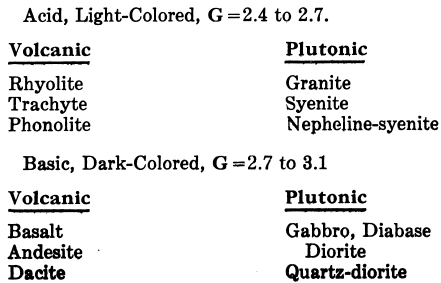Table of Contents
It is strongly recommended that these descriptions and examples of plutonic rocks be read with the specimens in hand, obtainable, as noted before, from the Geological Survey.
Granite
Granite is a coarse or medium- grained rock, composed of quartz, an acid feldspar or two of them (orthoclase, microcline, albite), and generally mica (biotite, or muscovite, or both). Instead of the whole or a part of the mica, there may be hornblende, or, rarely, pyroxene (augite). The commonest granite is that composed of quartz, feldspar, and black mica (biotite), and white mica (muscovite). Other varieties are biotite-granite, with black mica only; muscovite-granite, with white mica only; hornblende granite etc. These rocks contain 65% to 80% silica.
Pegmatite
Pegmatite is a name given to very coarse-grained rocks, commonly of the composition of granite; but there are also syenite-pegmatites and diorite-pegmatites. Pegmatite often contains large masses of pure feldspar, quartz, and mica, which can be quarried out separately. Pegmatite may carry tinstone, wolframite, scheelite, zircon, topaz, uranium-radium ores, etc.
Aplite
Aplite is granite of very even, fine-grained texture, occuring in narrow dikes cutting through larger granite masses or in the neighborhood of them. It is higher in silica than the main mass of granite, and it is supposed to have come from the same body of magma, solidifying after the main body.
Pegmatite is supposed to have had a similar origin, but coming from a part of the magma containing a higher proportion of water and other solvents, which kept the mass liquid and promoted the growth of large crystals. These solvents also favored the concentration of certain valuable minerals found in pegmatites.
Graphic Granite
Graphic Granite is composed of feldspar and quartz coarsely crystallized, the quartz being set in the feldspar in masses shaped somewhat like letters of the alphabet.
Greisen
Greisen is composed of quartz and white mica. It has been derived from granite by the conversion of feldspar into mica. It is important in being associated with tinstone.
Syenite
Syenite may be defined as quartz- less granite. The commonest variety is hornblende- syenite, which looks very much like hornblende- granite; but the absence of quartz distinguishes one from the other. Sometimes a little quartz is present. Some of the rock quarried as granite for building stone and paving blocks is really syenite. Syenite contains 50% to 65% of silica.
Nepheline-syenite
Nepheline-syenite contains the mineral nepheline instead of a part of the feldspar of ordinary syenite. It may carry corundum and sodalite, as it does near Bancroft, Eastern Ontario.
Diorite
Diorite is composed of hornblende and feldspar, the hornblende in equal amount or in greater quantity than the feldspar, so that the rock is dark. Often the feldspar shows as light-colored spots. The feldspar is mostly of the less acid varieties, oligoclase and labradorite. The structure is apt to be finer-grained than that of granite and syenite. Diorite sometimes has quartz, and then may look like granite, particularly if the feldspar is about as plentiful as the hornblende.
Amphibolite or hornblendite consists mostly of hornblende.
Gabbro
Gabbro is coarse to medium- grained, dark-colored rock, composed of pyroxene and basic feldspar, mostly labradorite. The pyroxene usually predominates, and is partly of the variety called diallage, partly augite. The crystals of pyroxene and feldspar are broad in outline. Contains 40% to 50% of silica.
Norite
Norite has the variety of pyroxene called hypersthene, as well as diallage. Olivine-gabbro and olivine- norite are characterized by the presence of olivine. The olivine may give the rock a greenish color.
Diabase
Diabase is of the same composition as gabbro, but the crystals of feldspar are long (lath-shaped), and they are set in the masses of pyroxene, giving the structure called ophitic. Olivine-diabase is common.
Pyroxenite is composed of pyroxene, with a little feldspar. Anorthosite is a light-colored rock composed mostly of the feldspar, labradorite, with very little pyroxene. Greenstone is a useful field name for any fine-grained greenish rock of igneous origin. Dolerite is a field name for gabbro, diabase, and diorite when too fine-grained to be distinguished.
Gabbro, norite, and anorthosite are associated with deposits of magnetite, ilmenite, copper pyrites, and pyrrhotite.
Peridotite
Peridotite is a very basic, heavy (G = 3 to 3.3), green to black, coarse-grained rock, sometimes schistose, composed mostly of olivine (peridot), the other minerals being pyroxene, hornblende, with sometimes magnetite, garnet, etc. Very little or no feldspar. It usually occurs in dikes and bosses. Contains 35% to 45% of silica. It is very high in magnesia (35% to 48%). Peridotite is interesting in connection with the occurrence of magnesite in serpentine rocks, which are generally the result of changes in peridotite. While it generally changes to serpentine, it occasionally changes to tale. By continued weathering it forms a rusty gossan or a rust-colored soil deficient in potash, and therefore a barren soil. Peridotite is an important rock, because it may contain chromite, platinum, and diamonds.
Dunite or olivine-rock
Dunite, or olivine-rock, is composed of olivine, with very little of other minerals. Usually light green. It is the principal platinum-bearing rock in the Ural Mts., Russia.
Kimberlite or blue ground
Kimberlite or blue ground is composed of olivine and biotite. It is a soft rock, much weathered: characteristic of the South African diamond mines.
The following tabular statement shows how the principal plutonic rocks are related to one another in respect to the minerals that compose them.
COMPARISON OF VOLCANIC AND PLUTONIC ROCKS

